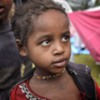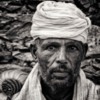Amharic (not Aramaic) and English are the two official languages of Ethiopia, although Amharic is the one most people speak. While there are up to 80 different languages and dialects spoken throughout the country, Amharic is the working language of the government, military and the Ethiopian Orthodox Tewahedo Church.
Amharic is a Semitic language used from medieval times to the present. There are several different Semitic languages, named after “Shem” (one of the three sons of Noah) in the 1780’s by a couple of German orientalists. About 22 million of the 90+ million Ethiopians speaking Amharic fluently. The language is exceedingly complex, written from left to right using Amharic Fidel as a script. There is no official agreement on how Amharic is transliterated into Roman (i.e., English) characters. Further, there is no real agreement on how many letters are in the “alphabet.” They use more than 275 symbols and character combination in what is referred to as “alphasyllabary” (I am not making up that word!). Each character set is sort of a vowel and consonant combination, with a series of modifiers thrown in for good measure; these modifiers change pleural, tense, gender, etc. Therefore, even though I learned what the equivalent of the letter “A” was (it is used on all vehicle license plates to stand for Addis Ababa), I learned nothing else of the language.
Everyone immediately will speak to Caucasians in English, but switch to Amharic the moment they are done. So, there is a very nice politeness, but you also feel like you are slightly at a loss! One thing that is quite interesting about the speech patterns of people is breathing in while speaking (something I noted in Swedes also). You get the sense the person is gasping, but they are actually saying a few words. It is more often at the end of a sentence, where they will breath in for the last 2 or 3 words. It also seems that certain words are just spoken on the inhale no matter what – although I couldn’t for the life of you tell you what one of the words means.
A few points about the people, religion and government. There are about 90 million in the country, with about 50% Muslim and about 50% Ethiopian Orthodox Tewahedo Church. Therefore, there are many churches and many mosques around the city and countryside. In fact, the largest mosque in Addis is located immediately within the Merkato district, the largest shopping market in all of Africa. This market is huge, sprawling and completely illogical, with a haphazard arrangement to everything. Filthy and seeming without any amenities, they are thousands of stalls and shops squashed together in several square miles of space. You could get lost here for days.
There has been quite a melting pot of cultures in Ethiopia over the years, and so there is a lot of intermarriage between Arabs, Africans, Asians and Caucasians. The mix creates an interesting blend of facial and physical characteristics. While hair is short and curly, the complexion tends to be very light to medium brown, quite sharply contrasted to the much darker skin of a Nigerian or Central African republic. The Orthodox Christians are quite conservative, most carrying symbols of the cross with them at all times. In fact, nearly all of the jewelry shows religious symbolism, with a cross shape overall dominant in theme for all pieces of jewelry.
The families are also distinctive, with most Muslims having between 8-12 children in their families, while most Orthodox have only 1-2 children. Interestingly, the more wealthy the person, the more likely they are to have more children. Therefore, the number of children is not part of a family work force, although nearly 80% of Ethiopians are involved in farming or agriculture.
There is a very high infant mortality, one of the highest in the world. Most deliveries occurring in rural villages by local medicine women. Consequently, there is an average life span of Ethiopians of only 52-55 years. The most common causes of death in adults is still infectious diseases, with malaria, TB, and bacterial diseases the most common, while the diarrheal bacterial induced diseases are most problematic in infants and children. Therefore, while there is an interest in cancer prevention and treatment, it is much less significant than infectious disease prevention.
Cervical cancer is the #1 killer in Ethiopia and there is no cervical cytology (PAP) screening program at a government or national level. Educated and more well off individuals will have cervical screening, but the vast majority of the women are not screened. It would seem to me that some effort put into “mobile” cytology screening taken to each village, with “positives” referred to larger centers, could put a major dent in this preventable cause of death. Sexual promiscuity is high, although I found the following observation quite interesting: instead of having a Bible or Quran in the hotel night stand, they had 2 6-packs of condoms! Clearly this sends a message about prevention, but also about the extent of the problem.
Just a comment about bureaucracy: there is a form for everything, the form has to be completed 2-4 times (not duplicate or carbon paper, actually filling it out 4 times), and there is a ministry or office for anything and everything! Really, it is just incredible to walk around and see all of the headquarters, centers, or national offices. An example: There is a major effort to dam the Nile river to create hydroelectric power to help stave off the nearly daily power outages.
Towards this end, there is the “Office of National Council for the Coordination of Public Participation on the Construction of the Grand Renaissance Dam.” When I entered the compound, there was a sign on the door that stated: “Closed Until Further Notice.” Basically, this is identical to the internet and electricity and water service in the country.
Many restaurants have no running water. Instead they have a large bucket with a plastic jug floating in it. When you need to wash your hands, you dip out the water and pour it over your hands as you try to soap, clean or wash them! The electricity goes off at least 1-3 times per day, often for extended periods. It is abrupt without any backup, and so if you happen to be working on an electronic product at that time, the potential for “surge” or “frying” is high. Of course, worse yet, if you are doing something on-line, it will be instantly lost, and the connection is not restored for some time. There are 10 GB of bandwidth for the entire hospital. This means if you try to download an article that is more than a few hundred kilobytes, it will timeout before the task is completed. There is no difference between wireless and cable, with both services equally as intermittent and unreliable. I felt so sorry for the physicians as they wasted so much time waiting for information or results to appear—only to lose them a few seconds before they seemed to be “loaded.”
- The Ethiopia series continues next week with part 3, Time and Date.
- For part 1, Getting to Addis, click here








Comments (2)